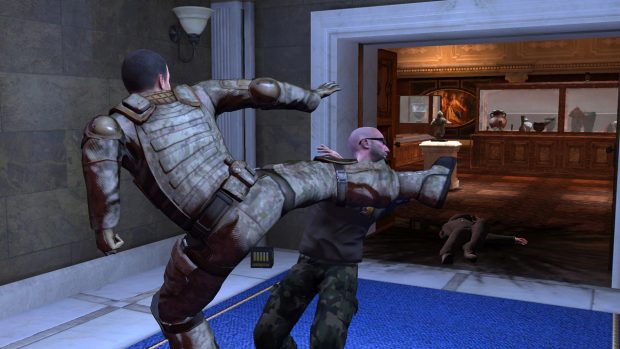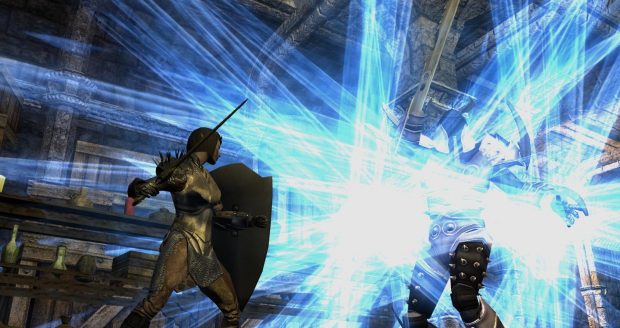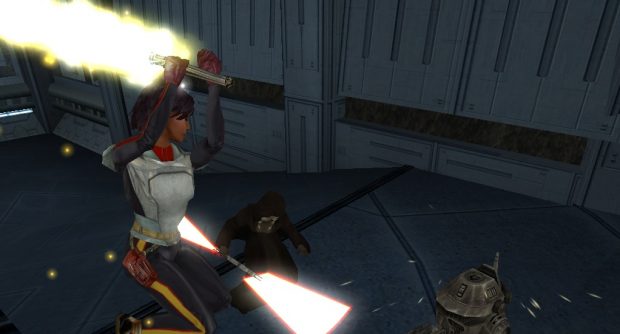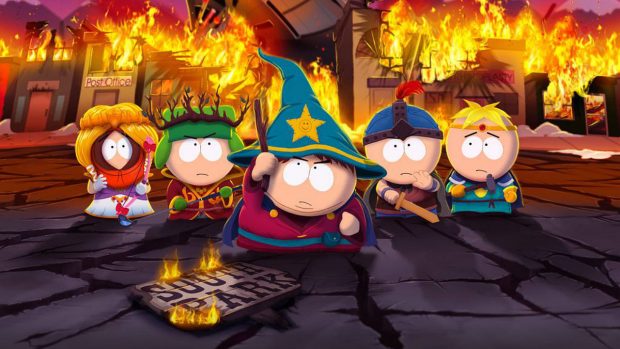“If you treat them as the enemy, it's not going to be a good relationship.” Obsidian's Feargus Urquhart on publishers
Big Boss
Since its foundation in 2003, Obsidian Entertainment has worked with seven different publishers. Commencing with LucasArts on Knights of the Old Republic II, Obsidian has since signed contracts with Atari, SEGA, Bethesda, Square Enix, Ubisoft and most recently, Paradox Interactive. In fact, up until Pillars of Eternity [official site], every single game Obsidian had made was funded and distributed by a different publisher.
This is a highly unusual state of affairs, and has proved precarious more than once in the company's history. But it has also provided Obsidian with a unique insight into how the world of publishing works, and how the relationship between developer and publisher has changed in the last couple of decades. This topic is especially pertinent today, as new methods of funding and distributing games have seen a significant shift in the power dynamic between developers and publishers.
I spoke to CEO Feargus Urquhart about how it all works (and doesn't).
It's worth noting that Obsidian never intended to travel down such an atypical road. “When we first started the company, there was an expectation that we would find a publisher and we would work with them, and continually work with them, because that was our life at Interplay,” says Feargus Urquhart, co-founder and CEO of Obsidian Entertainment. “I think that world started to change literally as we were starting Obsidian, and I think it's just accelerated.”
Urquhart has experienced the games industry on both sides of the fence. In the mid-nineties he worked as a producer at Interplay, and later founded Black Isle as a subsidiary of Interplay, producing Fallout and its sequel, and cooperating with BioWare on Baldur's Gate. At that time, not only were the budgets for individual projects much lower than they are today, individual publishers were shipping many more games.
“As a producer back then I myself was producing like ten games, so Interplay was just doing a lot of stuff,” Urquhart says. “I was approving like twenty-five thousand dollar milestones [the amount a developer would be paid for reaching a certain goal]. Now we're talking a single milestone could be one and a half, two million dollars.”
This gradual shift toward much higher budgets for a smaller number of games means the risk a publisher takes for each game they finance has increased exponentially. In the nineties, a single poorly-selling game, while disappointing, would not typically spell disaster. Nowadays, one underperforming game can kill off a company. This has fundamentally altered how publishers relate to and negotiate with developers.
“In the nineties, publishers liked to sign up multi-product deals with developers. Basically they'd just sign 'em up, say, 'We're gonna publish your next three games'. And that's kind of disappeared,” Urquhart says. “There was never a meeting about 'Do we do Baldur's Gate 2?' and there was never a meeting about doing Fallout 2 really...we started to work on Fallout 2 before Fallout 1 came out.”
Nowadays, this is far less likely to happen. With modern development cycles, a three-game deal could amount to a contract lasting twelve years or more. If the first game underperforms, then the publisher is stuck with the deal for another eight years. “Because the stakes were so high, they also needed to understand if the game was successful before they wanted to sign up the sequel,” Urquhart says.
The growth of the industry, and the risks that have grown with it, also force both developers and publishers to make tougher choices. For example, Obsidian often have a waiting period between a game being finished and it coming out, particularly on consoles where there are various approval processes to go through. “We need people to be working on other stuff, whether it's DLC or other games, to get paid. But then the publishers are not necessarily comfortable signing up the sequel for ninety days. So I think that started to create this very different relationship,” Urquhart says.
The relationship between any given developer and publisher can even be challenged by events that aren't directly related to it. For example, if a new game developed by a publisher in-house sells poorly and plans for a sequel are cancelled, the publisher might then have a hundred programmers, artists and designers employed but without a project to work on. “But they have this other game and it looks pretty good and this external developer has done it,” Urquhart says. “And they're like 'Well, we could lay off these one hundred people, and have that external developer do it. OR we could just not sign. We're not contractually obligated to sign that independent developer up. And they're an independent developer, and they'll go find some other game, and we can move it internally.'”
Hence, Obsidian formed at a time when publishers were becoming far more cagey about signing on developers for extended periods of time, and were more inclined to either sign for a single game or bring the developer in-house by buying them outright. This is how Obsidian ended up migrating from publisher to publisher with every project.
Feargus points out that this had its advantages “The awesome thing about being independent is we've had the opportunity to work on Star Wars and do our on IP and do South Park and do Fallout,” Urquhart says. But it has also come with its own unique set of challenges. One of the major challenges was that no publisher works in exactly the same ways. Each contract is different in terms of what the publisher offers, what it demands, and who is responsible for what.
This has caused some unfortunate misunderstandings for Obsidian. In the mid-2000s, Obsidian earned a reputation for releasing buggy or unfinished games, with Kotor II, Alpha Protocol, and Fallout: New Vegas all receiving criticisms in that regard. But Urquhart states it has always been the case that publishers, not developers, are responsible for providing QA.
“Even back in the day when we were doing stuff with BioWare, or Blizzard for that matter at Interplay, QA was done at Interplay,” Urquhart says. “But then there are these weird situations. With Neverwinter Nights 2, Atari was closing down their Santa Monica office, which we were originally working for. So there was no test locally, and Atari was still trying to figure out where they were going to test games. So we came to the arrangement - now I'm pretty sure we'd already signed up to do the game - we then just came to the thing of like, we would hire thirty testers and then Atari would pay for them.”
Because of unusual situations like this, and the flak that Obsidian received for them, the studio now stipulates precisely the terms of QA in any contract they sign with a publisher. “One of the things that we've had to learn to do is to actually, in our contract, to say the publisher must put this number of QA people on the game as of this date. And KEEP them on the game for the extent of, you know, from when the game is ready to be tested all the way through like a month or so after the game has been released.”
There's no question that Obsidian's relationship with publishers has been a bumpy road, and one that at its roughest points, such as the infamous Metacritic bonus situation with Bethesda, almost destroyed the company. So when Obsidian had the opportunity to break away from the traditional publishing cycle with its wildly successful Kickstarter campaign for Project Eternity (later Pillars of Eternity), why did Urquhart ultimately decide they still wanted one?
“Whenever we have to dedicate ourselves to something like that it means we're not dedicating ourselves to the games,” Urquhart says. “As the world knows, 2012 was a tough year for us. So we had to build the studio back up a lot and development needed to be the focus. So a lot of it is we looked to a publisher to do the things that we don't have expertise in.” In other words, although Obsidian could finance the development of Pillars of Eternity, they didn't have the infrastructure to publish and distribute it, and it was easier to sign with a publisher that understood these areas well, rather than dedicating an entire section of their own company to it.
This is where Paradox came in. “They've really learned how to manage the digital marketplace,” Urquhart says. “I can throw out ten things that I know about managing things on Steam, but they know a hundred,” Urquhart also feels Paradox understand the kinds of game Obsidian want to make. “They just get crunchy, you know, enthusiast hardcore games like Pillars, and that just makes any relationship easier.”
There's a persisting notion within the games industry that crowdfunding liberates developers from the yoke of oppressive and demanding publishers. But Urquhart believes that crowdfunding simply leads to a different set of responsibilities, and in some ways more responsibilies than having a contract with a publisher. “It's kinda scary spending your own money sometimes. There's that old adage that people say particularly about Hollywood. 'Never spend your own money, always spend someone else's money,'” he says.
Of course, Obsidian are still spending somebody's else's money. The difference is that rather than being held to account by a handful of publishing executives, now they must answer to thousands of backers from crowdfunding sites like Kickstarter and Fig. But Urquhart points out that it's largely a similar relationship, with communication being key. “I think we do exactly the same thing with our backers as we do with our publishers now,” Urquhart says. “Funnily enough, when we turn a milestone for our publishers now, they get all these videos [that say] this is a feature, this is what's happening.”
In a curious twist of fate, dealing with fans and backers through crowdfunding has taught Obsidian a lot about how to maintain a good relationship with publishers. The importance of regular updates, of listening to feedback and giving the publisher the opportunity to hold Obsidian to account. This has resulted in some significant changes to how that relationship worked even a few years ago.
“Almost every agreement that I've signed whether on the development side or on the publisher side has this sort of generic language that says that the publisher, with five business days notice, can come to the developer and see everything that they're doing,” Urquhart explains. “But what we've changed it to recently; it's not that they're able to, they have to. They must come here every thirty days or every sixty days or every forty-five days. It's a material requirement of the agreement that they come on site and they hang out with us.”
Urquhart concludes our discussion with two pieces of advice for developers and publishers respectively. On the development side, he believes it's crucial not to treat the relationship with a publisher as adversarial. “If you treat them as the enemy, it's not going to be a good relationship. If you flip 'em off or whatever, just say 'Hey those guys are idiots,' now you've created this relationship where the people that are going to be heavily involved in what your game is don't want to be in the same room as you.”
On the other hand, Urquhart urges publishers not to treat publishing as a zero-sum game. Indeed, he believes in some ways the industry is shifting back towards what it was like in those early days of Interplay and Black Isle, with lots of games being released, all with very different budgetary requirements. “It doesn't need to be one million dollar mobile console games, or one-hundred-million dollar games. There are absolutely these other avenues that independent developers can be super successful at,” Urquhart says. “Looking at games where selling a million units is seen as a success and not a failure.”















